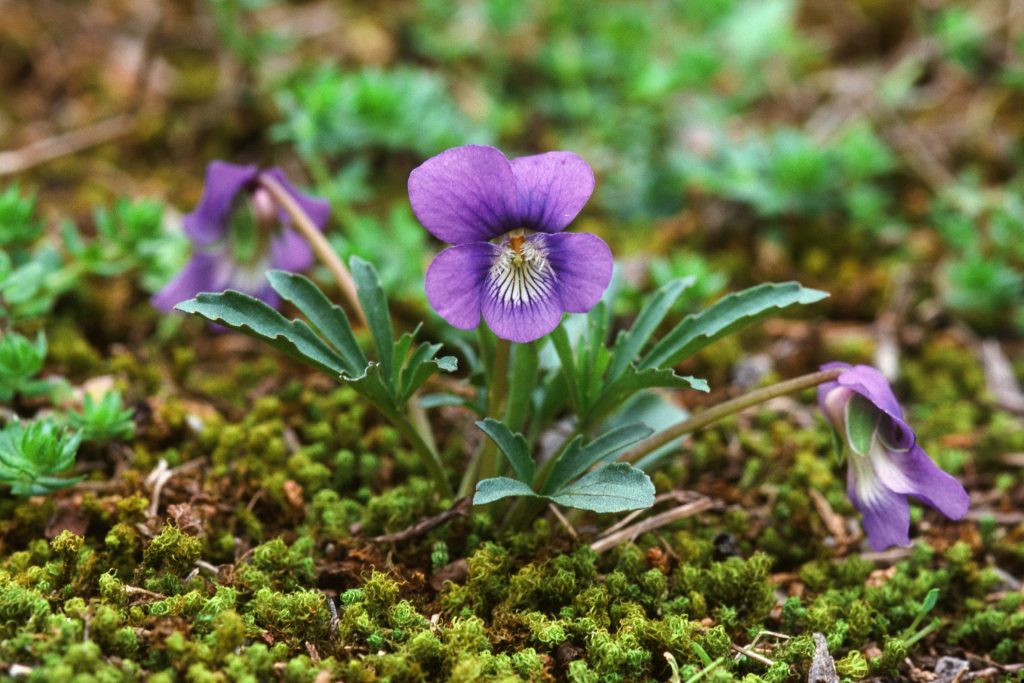Viola egglestonii
Kim’s rough notes. Illustrations: 2 photographs of Viola egglestonia (1 of seedpod), 1 drawing.

Section Nosphinium, subsect. Boreali-Americanae [NEW classification, 2010].
name accepted by ITIS. Name V. septemloba LeConte ssp. egglestonii (Brainerd) McKinney is not accepted by ITIS.
IPNI lists it as: Viola septemloba subsp. egglestonii (Brainerd) McKinney — Sida, Bot. Misc. 7: 33. 1992
For website, see Bookmarks/viola/ITIS: http://www.itis.usda.gov/
Listed as a threatened species in Endangered and Threatened Plants of the United States, 1978. Edward S. Ayensu, Robert A. de Filipps et al. Smithsonian. Washington, DC.
http://plants.usda.gov Plant Images:
Distribution by State: GA, IN, KY, TN.
Russell’s key separates on number of leaf blades (V. brittoniana 9-11 linear lobes, V. septemloba and V. egglestonii narrowly oblanceolate 5-7), then separates the latter two on the coarseness of the marginal teeth and whether the central lobe is divided (V. septemloba moderately or shallowly toothed, the central leaflet undivided, V. egglestonii coarsely toothed margin and central lobe divided). McKinney and Russell’s separation of these species also depends on the shape of the leaf base (ssp. septemloba with bases broadly cordate to cordate, ssp. egglestonii bases truncate to cuneate). Note that this latter publication refers to these two taxa as sub-species without specifying of what they are sub-species. This seems to be in the recognition of their compound/hybrid origin?? But this publication only lists ‘missouriensis’ and ‘sororia’ as varieties again not mentioning of what they are varieties. No one mentions the difference of the limestone substrate in which V. egglestonii grows, compared with the very sandy acid soil location of both V. brittoniana and V. septemloba.

NYBG Herbarium database:
Name: Violaceae
Viola egglestonii Brainerd (Holotype) Image: JPEG Available
Location: United States of America. Tennessee. Davidson Co. West Nashville. Collector: E. Brainerd 43
10 May 1910 Description: Transplanted from limestone barrens, West Nashville, Tennessee, May 1909; Eggleston donor. Flower. Habitat: Limestone barrens. Publication: Bull. Torrey Bot. Club. 37: 526. 1910.
Verified: L. E. McKinney. 1986. Other: NY Specimen ID: 18234
Collection notes: From transplanted material originally collected by Eggleston in May 1909
Comments: Type cited in the original publication is W. W. Eggleston no. 4421, collected 26 May 1909. Flowers and fruit described from cultivated material. Annotation by J. Burgess, 1986.
Growing in limestone area east of Nashville, TN in and around the Cedars of Lebanon State Park. It was growing around the gate of the park, and just inside the gate on the southern side of the road, in the cedar glade growing with a small sedum. No other trees grow in the cedar glades because there isn’t enough soil. The trees around are Eastern Red Cedars, also Hickory and Red Oaks, all growing on limestone. Also in flower at the same time and in the same places is Levenworthia, white flowers with yellow centres, 6 April 1999. Could the origin of this viola be a hybrid between V. missouriensis and V. sagittata or V. pedatifida. Viola missouriensis was also growing there, blue flowered, with a leaf the shape of V. cucullata, but a flower more like those of V. sororia, and it was on alkaline soils.
Seeds light brown, 2.4 x 1.2 mm.
Viola egglestonii is often called the Tennessee Violet because it is found in Tennessee (but it is also found in Kentucky and neighboring areas).
CALCAREOUS SUBSTRATE